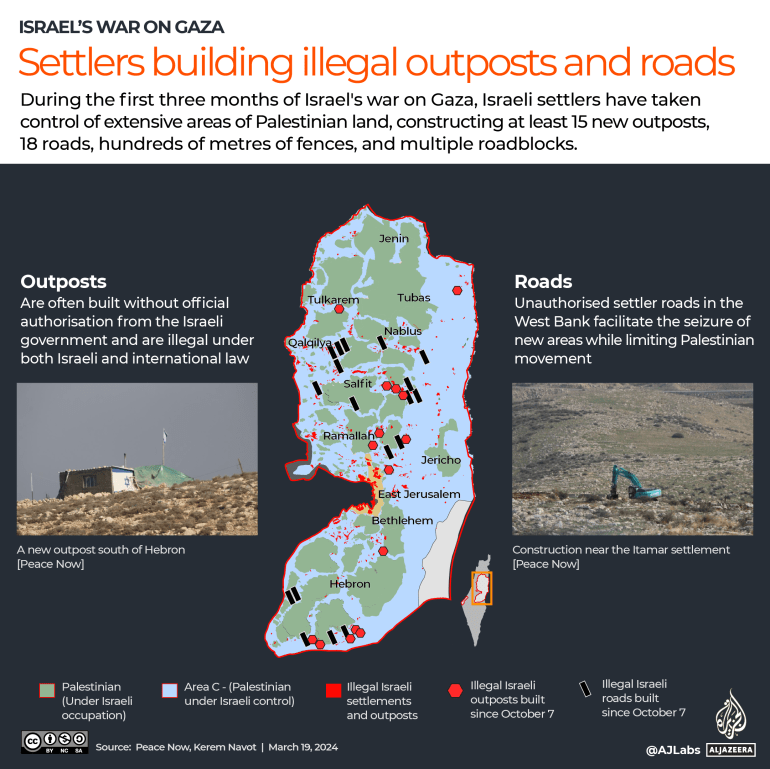Such trends can be seen across Area C, where settler shepherd outposts managed to seize up to 7 percent of the land by 2022, according to research done by Israeli NGO Kerem Navot.
According to preliminary estimates by the NGO, that figure has likely multiplied in the last two years alone, with thousands of additional dunums [hundreds of acres or hectares] seized by these shepherds since October 2023, taking over land once used by Bedouins.
“They are not only shepherding, they literally try to live the life of the Bedouins,” Tariq said of the settlers. “They build tents, they keep donkeys, horses, camels, goats, sheep. They even dress like us Bedouins. They speak and sing Bedouin songs.”
Tariq chuckled. “You know, it’s really funny because those people really don’t know how to do things. They just imitate.”
As each tense day unfolds in Umm al-Khair, the children keep themselves occupied.
Outside at the community centre, an eight-year-old boy named Arafat pushes around an empty baby carriage, “selling vegetables”.
“Potatoes! Watermelon! Cucumbers!” Arafat bellows.
He is a precocious young child, sharp and never shy with strangers after years of solidarity activists coming to the village.
He gave a price for his imaginary goods: “Five shekels ($1.37) per kilo,” and completed the “transaction” while reporting on how business has been. “This week has been OK,” the little shopkeeper said casually.
Earlier that day, settlers had come to Umm al-Khair, confronting and cursing the villagers. Arafat has had his own run-ins with the settlers.
“Just the other week, they came and attacked my home and pepper sprayed my father and he went to the hospital,” he said, dropping the shopkeeper persona and ignoring the jarring transition between his play and the reality of settler attacks.
Arafat was referring to June 29, when the teenage settlers entered his family’s home. When the family tried to push them out, they recounted, the teens attacked several family members with pepper spray.
Arafat’s father, Muhammad, had to be taken to hospital.
But immediately after mentioning that recent trauma, Arafat turned to a 20 shekel bill lying on the dirt ground nearby, picking it up.
“Is this yours?” he asked while holding up the bill, running up to everyone he saw in the village. “Is this yours? Is this yours?”
Mixing imaginary “business” with real-life “trauma” comes seamlessly to Arafat and other children in the community.
Yet, in recent weeks, parents in the village have reported their children waking up at night with nightmares of being attacked and shot at by the settlers.
Preferential treatment for chickens
The abutting settlement of al-Karmil, which crowds Umm al-Khair on the same hill, was established in 1980 – and largely on land the villagers’ elders started buying in the 1950s, the villagers said.
The first demolition orders on their homes were issued in 1995, they say, and the first demolitions took place in 2007.
There have been periodic demolitions ever since – nearly the entire village is under demolition orders – however, hostility and violence from neighbouring settlers have escalated since October 7, when Hamas attacked southern Israel and Israel began its war on Gaza.
In one incident, leaders from the village, including Tariq and Eid Hathaleen, were held at gunpoint by neighbouring settlers they knew personally.
These threats and attacks have intensified since June 26. On that day, the ICA demolished 11 structures in the village, leaving 28 people homeless, including 20 children.
Eid Hathaleen, a 40-year-old father of five girls, has spent years documenting such demolitions across the South Hebron Hills. But seeing his own home of 18 years demolished that day was still difficult to grasp.
“I thought: ‘Am I dreaming? Or is it the truth?’” recalled Eid, a calm and soft-spoken man, wearing his signature cowboy hat.
“But when I closed my eyes and opened them, I realised through the noise of the bulldozer, the shouting and crying of my community around me – it’s true. It’s happening.”
